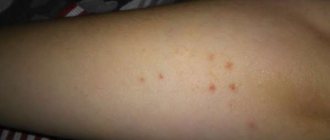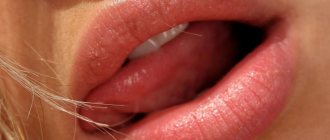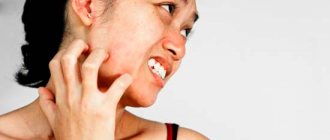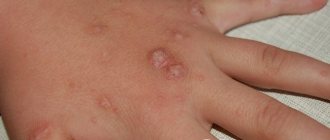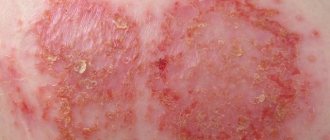Pimple on the face with blood - causes of appearance, treatment rules
The localization of a phenomenon such as a blood pimple can vary on the human body. Moreover, these can be either single neoplasms or numerous ones. In addition, such a rash is not always a pimple itself. So what could be the reasons for the appearance of rashes that are filled with blood, or at least that’s what they look like?
Description
The following types of acne can form on human skin:
- Comedones. Most often they look like small black dots on the skin. However, there are also white comedones, which look like small bumps. Such formations are absolutely painless. When pressed, a yellowish “rod” emerges from them, consisting of subcutaneous fat.
- Blackheads (acne). These are inflamed bumps on the skin filled with pus. As acne matures, a white head appears on its surface. Often comedones turn into acne. This usually occurs when an infection enters the wound during squeezing.
- Deep subcutaneous acne. They are difficult to detect on the skin. These formations are located in the deep layers of the epidermis. Subcutaneous pimples often develop into boils - large, painful ulcers.
A blood pimple is one of the types of acne. Such formations on the skin have the following features:
- Blackheads can be bright red or purple in color. Less common are bluish and black pimples.
- It seems to a person that the bump on the skin is filled with blood. Actually this is not true. Blood pimples are composed of pus, just like regular acne. The bright red color is given to them by dilated blood vessels in the inflamed area.
- When you press on the pimple, blood oozes out. This occurs due to damage to blood vessels. Under no circumstances should you try to squeeze out this type of acne. This can lead to prolonged bleeding and infection of the wound.
What are skin blisters?
A hollow formation raised above the top layer of skin, filled with serous (serum) or colored fluid, these are watery blisters or blistering rash. The dimensions of the cavities are 1-5 mm in diameter.
These formations are called vesicles. At the initial stage of formation, the bubble with liquid is covered with the epidermis (the top layer of skin). Its base and the area around it become inflamed.
When the neoplasm is destroyed, weeping reddish erosions are formed.
The accumulated fluid causes the bonds between cells to break and the epidermis to separate. Infectious agents (viruses, microscopic fungi) infect the spinous layer and accumulate in the fluid of the vesicle. After the rash elements dry out, scales and crusts form, which peel off after a while. The damaged areas of the skin have a pale pink tint.
Individual blisters on the skin containing fluid can turn into pustules (or pustules). They are larger in size - more than 5 mm. The inflammatory process affects not only the dermis, but also the subcutaneous fatty tissue.
The abscess is filled with dead and living leukocytes, bacteria, metabolic products, and toxins. Large blisters (more than 10 mm in diameter) filled with erosive fluid are called bullae.
They occur in different areas of the skin, have three specific layers, and their accumulations are diagnosed as bullous dermatitis.
Localization
Bloody pimples form most often on the face. However, this is far from the only place where they are localized. Such rashes may appear on the following areas of the body:
- back;
- hips;
- buttocks;
- pubic area;
- breasts
Red blackheads can form on the lips. They also occur on mucous membranes. Bloody pimples in the mouth are a common occurrence. Most often, the rashes are multiple in nature and appear simultaneously in the mouth and on the cheek. Bloody acne can also appear on the tongue; it is popularly called “tipun”.
Blood blisters on the tongue, sides, and tip of the tongue
Bloody pimples and blisters are also very common on the tongue. Typically, a huge blister of blood appears on the tongue or close to the middle or tip of the tongue. Bloody blisters can also form on different sides of the tongue. It is also possible to have more than one blood blister on the tongue if there are many of them. , they are usually smaller in size.
Bloody bubble on tongue
The most common causes of small to medium-sized blood blisters on the tongue are injuries, most often due to tongue biting. However, the infections and diseases and conditions discussed can cause blood blisters on the tongue. They are usually very painful and cause a lot of discomfort .
Depending on the size and severity of the blood bubble, you may have difficulty and pain in speaking, or may not be able to speak at all. Chewing and swallowing food can also become very painful processes.
Causes
Why do bloody acne form? This is usually a consequence of various pathologies or an unhealthy lifestyle. The following reasons for the appearance of such rashes can be identified:
- disruption of the endocrine glands;
- excessive consumption of fatty foods;
- gastrointestinal pathologies;
- liver diseases;
- frequent stress;
- alcohol abuse and smoking.
To get rid of red blood pimples forever, you need to eliminate the cause of their appearance.
Sometimes, to normalize the condition of the skin, it is enough to change your lifestyle: reduce the fat content in your diet, stop drinking alcohol, quit smoking.
But in many cases it is necessary to undergo treatment for the underlying disease. After all, such acne may be just one of the manifestations of serious ailments.
Question answer
Regularly, after severe stress, a rash appears on the hands, sometimes with blisters. What could it be?
If the rash is closely related to nervous experiences, it is neurodermatitis. Its treatment is closely related to the normalization of a person’s mental state. The doctor prescribes a neutral diet for the patient, good sleep, and the elimination of stressful situations and physical fatigue. In severe cases, take antidepressants (“Afobazol”, “Doxepin”).
Can the fungus go away on its own?
It is impossible to completely get rid of a fungal infection. When the immune system is strengthened, the number of fungal colonies decreases, and the disease ceases to manifest itself externally.
Bubbles appear on the hands, then disappear, and crusts form in their place. Bubbles appear next to them again. This happens in circles. What could it be?
The symptoms are similar to eczema. The cause of the disease can be bacteria, an allergic reaction, exposure to chemicals, or internal disorders in the body.
Source: https://gidroz.ru/estetika/krovyanoj-pryshch.html
Mycotic (fungal) diseases of the skin
Even more interesting:
What is Unidox prescribed for?
Ulcers due to thrush in women
You can get a fungus anywhere. But few people know that almost every person has fungal spores in one quantity or another on their body. They just begin to develop when the body’s defenses fall. And when the skin is not able to limit the proliferation of the fungus. Then the person complains of blisters on the heels: they itch like bites, bring pain and discomfort, and spread over a large area over time. The “favorite” places for fungus are the heels, the space between the fingers, and the nail plates of the hands and feet.
Blister with blood under the skin
Many people know how to deal with common acne. However, the appearance of bloody pimples frightens and worries patients. These formations do not look aesthetically pleasing, especially on the face.
People try to get rid of such rashes as quickly as possible, and often take the wrong actions.
Why do these pimples appear? And how to deal with them? We will answer these questions in the article.
Differential diagnosis
Only a doctor can differentiate blood acne from other skin neoplasms. Therefore, if such acne appears, you should consult a dermatologist. Redheads may be similar in appearance to the following formations:
- Patients often mistake hemangioma for bloody acne. In fact, this formation is a benign tumor consisting of blood vessels. It looks like a raised spot of red, burgundy or purple. If damaged, hemangioma can undergo malignant degeneration. Therefore, if you notice a bloody pimple on your skin, you should never touch it or try to squeeze it out.
- A bloody pimple on the lip may resemble a herpetic rash. Often, patients begin to treat the affected area with antiviral ointments. However, herpes and blood acne are treated with completely different methods. A lip fever usually appears as a watery blister. However, if the blood vessels are damaged, the rashes can fill with blood.
- Bloody pimples on the body are very easy to confuse with manifestations of dermatitis. In some forms of this disease, red blisters appear on the skin. Dermatitis is an allergic disease and is accompanied by severe itching. The patient feels a burning and tingling sensation in the affected area. Blood acne usually never itches.
Typically, a dermatologist makes a diagnosis during an examination. Only a specialist can differentiate the different types of bloody formations. To clarify the cause of acne, the patient may be prescribed additional diagnostic procedures: a biochemical blood test, hormonal tests, as well as examinations of the function of the liver and gastrointestinal tract.
Possible complications
The unpleasant consequences of blood acne usually occur when squeezing. In this way, you can very easily get an infection, and a small pimple will turn into a huge abscess. In addition, the contents of the acne, when pressed, can enter the bloodstream, which often becomes the cause of sepsis (blood poisoning).
Another danger is that the red bump may not be a bloody pimple, but a tumor. Damage to benign tumors can cause skin cancer.
Drugs
To radically get rid of bloody acne, it is necessary to eliminate the cause of its appearance. The patient is recommended to follow a diet low in fatty and spicy foods, and also give up bad habits. If acne appears as a result of any disease, then it is necessary to undergo a course of treatment for the underlying pathology.
Source: https://geraklionmed.ru/voldyr-s-krovyu-pod-kozhey/
Causes
Blisters on the skin form as a response of the body to the action of internal and external irritants of a mechanical, burn, allergic, symptomatic nature.
Mechanical
Blisters on the body can be the result of friction or prolonged pressure:
- uncomfortable, inappropriate shoes;
- tight clothes with rough seams;
- the skin itself in the folds, between the legs;
- tools of physical labor and other objects.
In these cases, single blisters appear on the feet, hands, under the arms, and in women, under the mammary glands.
Burns
Long exposure to the hot sun causes severe redness. Ultraviolet burns of white, delicate skin are often accompanied by small (vesicles) and large blisters - bullae, which can be seen in the photo below.
Blisters resulting from contact thermal burns are the most voluminous and painful . When there are a lot of them, a large amount of fluid flows out of the body, which threatens dehydration. When the blisters burst, they open a wide wound surface that is easily accessible to pyogenic bacteria.
Bloody pimple: causes, treatment methods, review of drugs
Many people know how to deal with common acne. However, the appearance of bloody pimples frightens and worries patients. These formations do not look aesthetically pleasing, especially on the face.
People try to get rid of such rashes as quickly as possible, and often take the wrong actions.
Why do these pimples appear? And how to deal with them? We will answer these questions in the article.
Procedures
If acne cannot be treated with local remedies, then you can try to get rid of it using physiotherapy:
- ozone therapy;
- electrocoagulation;
- laser therapy.
These methods are virtually painless, but the patient may experience slight discomfort during acne removal. The skin heals quite quickly after the procedures. However, if the cause of acne is not eliminated, then after some time the rash may reappear.
Folk remedies
Traditional medicine can be used to get rid of acne only as an additional method of therapy. You should not completely rely on such treatment methods. However, if you use home remedies along with antibacterial ointments and gels, this will speed up the skin cleansing process.
Traditional medicine recommends the following remedies for red acne:
- Plantain juice. This product disinfects the epidermis well. The juice is squeezed from the leaves of the plant and the rashes are treated with it several times a day.
- A solution of table salt and baking soda. Dissolve 1 teaspoon of each ingredient in a glass of warm water. Gently wipe the affected area with the resulting mixture. 1 hour after applying the solution, you need to wash yourself well.
- Homemade mint lotion. The dried herb should be boiled in water (in the proportion of 1 tablespoon of mint per glass of liquid). Add 1 teaspoon each of lemon juice and boric alcohol to the composition. Use this product to wipe problem areas twice a day.
Prevention
How to avoid blood acne? To ensure your skin always remains clean, you must adhere to the following recommendations from dermatologists:
- Eliminate excess fat, fast food, spicy foods and sweets from your diet. Regularly include fresh fruits and vegetables in your daily menu.
- When the sebaceous glands are overworked, use special skin care products.
- For oily skin, it is recommended to wash your face with chamomile and calendula decoctions.
- It is useful to wipe your face with aloe juice after each wash.
These simple measures will help prevent the occurrence of blood acne.
Source: https://FB.ru/article/437854/krovyanoy-pryisch-prichinyi-metodyi-lecheniya-obzor-preparatov
Pimple with clear liquid inside
All skin imperfections are associated with internal diseases, as the founders of traditional Chinese medicine argued several thousand years ago. Modern immunologists and allergists, in particular Professor V.A. Revyakina, have proven the dependence of rashes on hormonal problems and allergic reactions.
Watery and other pimples in medicine are called “rash elements” and are distinguished by size and reasons for formation. For example, with insect bites, contact dermatitis, hormonal and metabolic disorders, blisters appear that look like a dome without a cavity.
Bubbles or vesicles are small pimples with a diameter of 1–5 mm, filled with liquid. Occurs with chickenpox, herpes simplex and herpes zoster, allergic dermatitis, eczema, dyshidrosis. They can be more or less painful, depending on the body's reaction to the infection or allergen.
With improper treatment or lack of therapy, water pimples become inflamed. The cavity inside is filled with bacteria, toxins, and leukocytes. If you scratch the blisters and bubbles, squeeze out the pustules, they will not heal for a long time. Red spots and scars then remain on the skin.
To reduce problems with skin rashes, it is recommended to follow preventive measures. So, for example, many infections can be transmitted during contact with a sick person or through personal hygiene items and utensils.
Therefore, it is recommended, whenever possible, to avoid contact with a person who has clear blisters.
Each family member must use personal hygiene products: washcloth, towel, comb and other items.
Oddly enough, tanning is good for drying out acne with water inside.
One of the ways to dry out watery pimples is tanning. Thanks to tanning, the blisters dry out and, in addition, the germs that get on the skin are destroyed. However, you shouldn’t overdo it. Prolonged and intense sunbathing can lead to skin burns.
To avoid rashes on the body filled with clear liquid, tanning alone is, of course, not enough. Experts advise regularly cleansing your skin with a scrub. This product can be purchased at the store or prepared at home. If you prepare a scrub at home, it is advisable to use fine sea salt as the main ingredient.
If watery rashes form all over your body, you can take baths with chamomile, lavender or sage. These herbs will reduce itching and relieve inflammation.
To relieve these unpleasant symptoms, lubricating areas with a rash with calendula tincture is also suitable. In no case should you forget about proper nutrition.
Avoiding spicy and spicy foods, chocolate and citrus fruits is a good prevention of watery skin rashes.
Of course, pimples with liquid inside require immediate treatment. However, do not forget that self-medication can have a lot of negative consequences.
What to do
If small watery pimples on the face do not appear after shaving or applying previously unused cosmetics, especially in the area of the nasolabial triangle, you should immediately consult a doctor. Incorrect independent actions can only aggravate the problem.
Even if the rash is infectious in nature, or a symptom of a severe allergy or autoimmune disease, itching and pain must be relieved. Otherwise, a person will constantly scratch pimples, and they will turn into wounds or ulcers.
Therefore, along with the main course of treatment, the following is often prescribed:
- Analgesics and anti-inflammatory drugs for internal use: Ibuprofen, Nimesulide, etc.
- Means for external disinfection of bubbles: brilliant green, potassium permanganate solution, Castellani liquid, etc.
- Antihistamines to relieve itching and swelling: Loratadine, Suprastin, Cetirizine, etc.
- Gels and lotions with a cooling and soothing effect: balm “Golden Star”, “Rescuer”, etc.
When internally taking antibiotics in parallel, agents that restore the intestinal microflora are also prescribed: “Lactobacillus”, “Linux”, etc. As you can see, the course of treatment can be quite complex, so only a doctor can choose the optimal combination of drugs.
In this case, first of all, it is necessary to eliminate the influence of the allergen and provide the skin with maximum peace. Try to keep the affected areas of the body from coming into contact with clothing. To dry out the rash and relieve itching, use:
- zinc ointment or paste:
- antihistamines;
- corticosteroids.
We invite you to familiarize yourself with Atheroma - what is it and how to treat it?
Sometimes cauterization of rashes with alcohol tinctures (propolis, St. John's wort or calendula) or essential oils becomes effective. But here you need to be careful not to provoke an increase in allergic reaction and severe peeling of the skin.
For herpes
As I already said, it is not yet possible to cure herpes completely. But the following remedies help reduce discomfort and quickly dry out blisters in their active stage:
- antiviral drugs: Acyclovir, Viferon, etc.;
- immunomodulators: echinacea extract, “Immunal”, etc.;
- drying agents: zinc paste, sulfur ointment, etc.
If you do not tear off the crusts formed after opening the blisters, the ulcers after herpes will heal completely without a trace, and the active stage of the disease lasts no more than 3-5 days. It is very important not to miss the first signs of the virus during pregnancy, since herpes can lead to the development of complications or infect the newborn baby.
We determine the disease by the appearance of acne
Typically, with viral infections, red spots of varying diameters first appear on the skin, then watery blisters form within one or several days. Allergic acne is most often pink blisters of different diameters. They appear a few minutes or days after exposure to the stimulus and can quickly disappear without treatment.
How to determine the disease by the nature of the rash:
- pink vesicles with a depression in the center - molluscum contagiosum;
- severely itchy watery pimples on the lips and wings of the nose - herpes simplex;
- groups of red blisters under the armpits, on the sternum, back and neck - herpes zoster;
- quickly opening and drying out pimples on the head and torso - chickenpox;
- itchy watery blisters between the fingers, scabies in the navel area;
- skin redness, local swelling, blisters - allergic dermatoses.
With dyshidrosis, a rash forms on the hands and feet as a result of clogging of the sweat glands. Miliaria, in the form of a scattering of watery pimples, also appears due to blocked sweat glands. Such rashes are usually localized in the folds of the skin, on the neck, back, and groin.
Summing up
As you can see, small watery blisters on the face and body should not be ignored. They can signal serious and dangerous diseases. Moreover, you cannot open them and try to cure them yourself - the risk of spreading the infection and even infecting loved ones is too high. Therefore, it is better to go to the doctor immediately.
Source: //murow.ru/pryshch-prozrachnoy-zhidkostyu-vnutri/
Blood spots on the body: why do they occur and how to treat?
A person looks in the mirror and notices small red dots on the surface of the skin. One category of people does not pay attention to this, while the other begins to panic. How to understand the reason for their occurrence? But regardless of size, bloody moles can signal that some kind of disturbance is occurring in the body.
Blood spots on the body - what are they?
In some cases, red dots may appear and soon disappear on their own, which will indicate minor problems in the body or a chronic disease. But if the red dots do not go away, and in addition cause unpleasant itching, then most likely this is a signal of a serious illness.
Therefore, you should not ignore the body’s signal in the form of the appearance of blood spots on the body, regardless of whether they bring aesthetic or painful discomfort; be sure to make an appointment with a therapist who will conduct a full diagnosis.
Possible reasons
It is worth mentioning the most common factors that may hide the answers to the question of the appearance of red dots:
- problems with the liver and pancreas;
- vitamin deficiency;
- rheumatism;
- skin lesions;
- hemangiomas (red moles).
Here you can read more about what causes red moles on the body
Hemangiomas
Hemangiomas are red moles that can appear on the body at birth or at any time in an adult’s life. If we speak in medical terms, it would be more correct to call them angiomas.
Oncologists and dermatologists will say that red moles do not pose any danger to life, but there are cases when benign red dots degenerate into malignant ones . It is worth paying special attention to cases when a mole increases in size, changes color, or itches; it is in these cases that it is unwise to postpone a visit to a dermatologist until later.
It is necessary to get into the habit of going to the doctor at least once every few months and talking about tumors on the body. The doctor can decide to remove hemangiomas only in cases where they cause various types of discomfort to the patient.
Modern medicine eliminates moles:
- laser surgery;
- by radio wave;
- electrocoagulation;
- conventional surgery.
Hemangiomas, depending on the size and location of their formation, are:
- Branched - a characteristic type of swelling, consisting of dilated pulsating vessels. When pressure is applied to the red dot, it quickly fills with blood.
- Capillary - usually appear on the face and torso, as a rule, these are blue-purple or reddish spots from dilated vessels.
- Cavernous is a large dark blue formation on the body, filled with blood. The vessels are hidden under a thin layer of skin. They can develop on the head, in the uterus, in the muscles and liver.
Here you will find a similar article about hemangioma in a child.
Measles
Measles is a viral infection characterized by a rash that appears 3-4 days after the fever is first noticed. Before the skin rash appears, small pink spots appear on the roof of the mouth, but disappear after 1-2 days.
The rash first affects the face, then the skin behind the ears, the next in line are the upper half of the torso, arms, legs, and in three days the whole body will be covered. A distinctive feature of the spots is that they are large, the edges are uneven and seem to be raised above the surface of the skin. The disappearance of the rash occurs from top to bottom, in some cases scales remain. Then the body begins to recover.
Complications occur more often under the age of 5 years and in adults over 20 years of age. The most common are blindness, laryngitis, inflammation of the cervical lymph nodes, encephalitis, bronchopneumonia, and inflammation of the middle ear. Unfortunately, it cannot be said that complications of measles are rare cases, so the disease process should be under the supervision of a doctor several times a week.
The diagnosis is made at home, since diagnosis in such cases is not difficult. The local doctor can make a diagnosis based on the clinical picture.
If measles has a mild form of manifestation, then it is enough to adhere to bed rest, include remedies for sore throat and runny nose, drink plenty of fluids, tablets to reduce fever, vitamins and expectorants. An effective and reliable way to prevent measles today is
vaccination .
The virus is artificially inoculated, infecting the body, but in very small doses, so that the body naturally overcomes measles, developing immunity against it.
Chickenpox
Chickenpox appears in most cases on the face, torso, or scalp.
Depending on the course of the disease, the nature of the expression of the disease also changes: first, small red spots appear on the surface of the skin, which in a short period of time become transparent bubbles, then the bubbles become cloudy. Usually the size of the bubbles does not exceed 4-5 mm. In the next stage, the bubbles dry out, and brownish crusts form in their place.
Chickenpox is unpleasant because the rash is accompanied by uncomfortable itching. At the time of illness, new spots and increased temperature constantly appear.
In severe cases, a profuse rash spreads on the skin and mucous membranes of the eyes, mouth, sweat glands, and genitals. It is accompanied by high fever, nausea, poor sleep, lack of appetite, and severe itching.
You will find a photo of a chickenpox rash here.
Chickenpox treatment:
- If you have chickenpox, stay in bed. In order to prevent excessive rashes on the body, you need to change your bed linen more often.
- Under no circumstances should you wet the body, as the situation with the healing of the blisters may worsen. It is recommended to follow a simple diet that includes plant and dairy products.
- Drinking plenty of fluids helps your body tolerate heat better. The body must not be dehydrated. Since chickenpox takes away energy, efforts must be made to combat the lack of appetite and still replenish nutrients with food.
- If the body temperature is above 38-38.5 degrees, then the time has come to take antipyretic medications. Aspirin is not recommended for children under 12 years of age.
Sexual infections
Red dots on the genitals appear along with wounds, accompanied by itching and burning. In this case, this may be a symptom of many diseases that are caused by poor intimate hygiene or sexually transmitted infections.
The treatment of such a rash is quite unpleasant, but furatsilin, potassium permanganate, and antifungal drugs will help get rid of the red dots.
Sexual infections affect the external and internal genital organs: the uterus and fallopian tubes, vagina, seminal vesicles, prostate gland, urethra. With complications, the disease can affect the nervous and cardiovascular systems, other systems and organs.
The greatest danger is that the severe consequences of infection affect the reproductive function of the body, so self-medication for initial symptoms can only worsen a person’s condition. Seeing a doctor immediately is the most prudent and safest decision.
Features of rash with blood spots in children
If a child has red moles or dots from birth, they are most often benign and may disappear on their own over time. Experts cannot name a clear reason for the appearance of moles. However, you should not ignore the signals from your child’s body; you should definitely see a doctor to rule out the possibility of a health problem.
In children, hemangioma is very vulnerable and is easy to damage due to its delicate structure. If a seemingly small red dot is damaged, bleeding will follow, and then infection may occur. In each case of detection of points on the body, it is necessary to consult a doctor. Only the doctor decides whether to prescribe drug treatment or remove the hemangioma.
Typical localization of blood spots:
- on the face;
- on foot;
- on hands;
- on the body.
How to treat?
If you see a doctor right away, you can get an accurate diagnosis and then appropriate treatment. Thanks to modern medicine, we get rid of not only the disease, but also its manifestations.
Do not be afraid of a blood test or ultrasound of organs, which are most often prescribed in such cases. “We are what we eat,” said the ancient Greek sage Socrates, and he was not mistaken. The doctor will definitely advise you to adhere to a gentle diet, which in turn will reduce the load on the body: fiber, dairy products, fruits and vegetables.
Depending on the type of hemangiomas and the causes of their occurrence, the following treatment methods are used:
- consumption of vitamins C and K , which strengthen blood vessels. Vitamin C can be obtained from foods such as apples, garlic, wild garlic, parsley, orange, green peas, cauliflower, and rose hips. Vitamin K is found in cucumbers, chicken eggs, beans, broccoli, spinach, green cabbage;
- simple red dots are treated surgically;
- In case of viral infection of the body, cirrhosis of the liver, it is necessary to urgently consult a doctor. Inaction in such situations leads to death. If the doctor confirms the diagnosis, he will select the most appropriate form of treatment that will avoid complications;
- it is necessary to adhere to a diet , avoid mental and physical stress;
- moderate water consumption;
- for pathologies associated with rheumatism, a consultation with a rheumatologist is prescribed and anti-inflammatory drugs, gastroprotectors, anesthetics, and muscle relaxants are prescribed. In addition, the doctor will prescribe physical therapy, which includes shock wave, magnetic or laser therapy.
How to remove blood spots on the body?
Only a qualified professional should make the decision to remove or leave red dots. In some cases, simple hemangiomas are cauterized with carbon dioxide, X-rays, or surgically removed.
Doctors do not recommend self-medication so as not to worsen the condition.
Regardless of whether red dots on the body bother you or not, you should trust only a specialist who has the right to make a diagnosis, prescribe treatment and diet.
Seek advice from professionals.
Source: https://heal-skin.com/novoobrazovaniya/other-novoobrazovaniya/krovyanye-tochki-na-tele.html
Types of watery blisters
A blister is a cavity that is formed as a result of acute inflammation of the skin. The entire space is filled with a clear serous fluid (serum), sometimes mixed with blood.
Depending on the root cause, bubbles appear singly or in groups. They can rash locally in a certain area and generalized - from the head to the feet.
Blisters with fluid on any part of the body are distinguished by type:
- vesicles - small formations up to 5 mm;
- bullae - single- or multi-cavity large blisters measuring 10 mm or more;
- pustules are cavities with purulent contents.
The rash is small and round in shape; large bullae may be asymmetrical.
What is a blood blister on the skin?
A bubble or vesicle is a round formation on the surface of the skin, filled with clear or cloudy serous fluid with a diameter of up to 5 mm. The edging of the elements may be inflamed. After the contents are poured out, erosion appears - an open red wound. It becomes covered with a crust, which dries out and falls off, leaving no traces.
Such symptoms are characteristic of allergic reactions, eczema, and herpes. Sometimes the blisters turn into pustules, which indicates the bacterial nature of the pathology (for example, with pemphigus). Inflammation affects the deeper layers of the skin, which is why scars remain after the tissue tightens. Combing the elements significantly slows down healing.
Treatment Options for Blood Pimple
In some cases, a pimple that contains blood inside can be found on the human body. It has a lumpy character. The color varies from purple to black. If a person does not have a medical education, then this inflammation will look like a pimple with blood to him. Unfortunately, the situation requires careful diagnosis.
For this purpose, dermatological examinations are prescribed. Often papules are inflammatory in nature. They are formed through the accumulation of infiltrate or dilated state of blood vessels. Because of this, blood appears inside the formation. Most often, such negative manifestations can be seen on a person’s face.
In modern medicine, there are a number of reasons for this manifestation:
- disruption of the digestive system;
- improper metabolism or hormonal imbalance;
- failure to comply with basic nutritional standards;
- pathology in the liver;
- constant consumption of alcoholic beverages in large quantities;
- smoking;
- emotional intensity, stress, depression.
A pimple with blood is completely different from an allergic reaction. Rashes are caused by various reasons. Depending on this, the attending physician selects the further course of treatment. The specialist will prescribe the necessary tests, based on the results of which a diagnosis will be made.
Hemangioma is a disease whose main symptoms include the appearance of red, bloody pimples. When detecting them, it is important for a person not to try to damage the integrity. It is not allowed to pierce or squeeze out formations that appear on the skin. Hemangioma is an almost harmless disease.
The patient should be concerned not only about opening the pimple, because it may contain a large amount of pus inside. In this case, an inflammatory process is diagnosed.
The patient is advised not to touch the lesion and wait until the crust falls off on its own. In this case, the risk of infection inside the formation is reduced.
The situation can get worse at any time, so everything must be done to prevent it.
The further course of treatment largely depends on the nature, type and characteristics of the spread of acne. At the first stage, a person should go to a clinic to see a specialist in this field. He will prescribe tests that will identify the problem. It is important to maintain an integrated approach to treatment. In this case, you will be able to achieve excellent results within a short period of time.
Dermatologists offer several options for procedures that can help cleanse the skin of inflammatory formations:
- deep cleaning using an ultrasonic beam;
- peeling using laser or chemicals;
- ozone therapy.
These procedures can only be performed in the office of a professional cosmetologist. In order to prevent further formation of acne with blood on the skin, you must adhere to the following rules:
- it is important to pay enough attention to hygiene procedures every day, to use only high-quality, proven cosmetics;
- completely get rid of bad habits;
- review your daily diet - food should contain sufficient amounts of vitamins and minerals;
- drink minimal amounts of alcohol or completely abstain from it;
- eliminate stress or highly charged emotional states.
Masks help cleanse the skin. You can prepare them at home. Only natural ingredients should be used as the main components.
Only specialists in this field can determine the nature and further course of treatment for blood acne. It is recommended for the patient to strictly adhere to all the doctor’s recommendations. The disease should not be left to chance. A symptom may indicate the presence of a serious disease in the human body.
Treatment
Before carrying out any treatment, it is recommended to see a doctor, since in the presence of large blisters there is a possibility of developing Quincke's edema, which can lead to suffocation.
If an allergic reaction is caused by taking medications or food products, it is recommended to exclude them (take drugs with analogues). If the blisters are the result of insect bites, then you don’t have to wait for improvement and immediately start using antihistamines. Most often, doctors recommend the following drugs:
The dosage and duration of taking these medications should be prescribed by your doctor (usually the duration of use does not exceed 2 weeks).
Also, in the presence of large blisters, steroid ointments are indicated:
Regarding steroid ointments, you need to pay special attention to the fact that they are harmful only when they are taken “thoughtlessly” not as prescribed by a doctor. Only an experienced doctor can select an effective hormonal drug and calculate the dosage that will achieve a clinical effect without side effects.
To date, there are no completely harmless topical corticosteroids. Sometimes even experienced specialists find it very difficult to calculate the required dosage. After all, long-term use of most glucosteroid drugs can lead to significant thinning of the skin, the appearance of stretch marks and the development of hidden infections.




